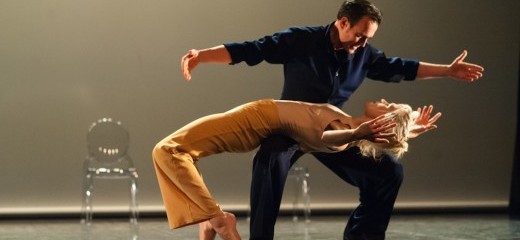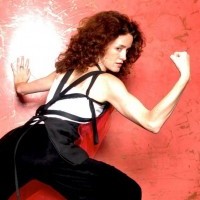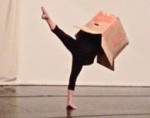
It Takes Two
by Carolyn Merritt
What will become of us if we can’t learn to see and be with others? Can we see ourselves as others do, in order to navigate the path toward greater communication and understanding, without relinquishing our identity in the process? Together, Union Tanguera and Kate Weare Dance Company probe these questions in Sin Salida, their stunning cross-pollination of Argentine tango and contemporary dance recently presented at the Annenberg Center. Titled after Jean-Paul Sartre’s 1944 play No Exit (Huis clos in French), the production weaves together essential elements of each form with points of connection and tension, positing dance as a metaphorical map for human relations.
Five chairs mark the upstage space and a single light hangs above a piano downstage left, evoking a tense audition. Film images, in negative, appear against the backdrop—a woman tending her hair at a vanity, a couple framed in a doorway, their essence muddied in the wash of black. Union Tanguera Co-Artistic Directors Claudia Codega and Esteban Moreno dance an elegant, salon-style tango that combines the outward focus and enlarged vocabulary of stage tango with the inward intention of the improvised, social Argentine form. They spin as if in balancé turns to the sounds of tango waltz, heads and focus trailing behind. Moreno lifts Codega to fan her legs wide in a split en l’air. Their costuming—stiletto heels and a tight red, knee-length dress slit to the hip for Codega, and dark dress shirt and slacks for Moreno—reference “traditional” tango aesthetics and gender dynamics.
Acclaimed pianist Pablo Estigarribia accompanies the dancers with Argentine composer Gustavo Beytelmann’s wandering, jazz and tango melding score. Estigarribia propels the conversation into and out of fusion, as the score’s division functions like music at a milonga (tango social dance). Each song becomes a tanda (set) that signals a new formation of dancers, and each formation of dancers offers a different view of tango, modern dance, or some combination of the two.
Kate Weare Dance Company members Thryn Saxon and Nicole Vaughan-Diaz borrow tango vocabulary and concepts, resolving deep lunging turns in giant sweeping boleos, and hooking elbows around limbs in an upper-body twist on ganchos. Saxon’s liquid fluidity is a nice counterbalance to Vaughan-Diaz’s razor-sharp precision. Diving to the floor, Saxon snakes from neck to toes in the largest worm I’ve ever witnessed. In a feat of strength and poise, Vaughan-Diaz rises and unravels from a cross-legged crouch to a perfectly relaxed standing thigh stretch. The pair exemplify key traits of modern/contemporary dance in their idiosyncratic movement styles and their ever-shifting relationship to the floor.
Hovering his palm inches from Vaughan-Diaz’s chest, Moreno showcases the primacy of energy in tango’s lead and follow. He weaves his hand from high to low and she tracks it with her chest, her spine erect as she slowly pliés to maintain the distance and the invisible bond between them.
In a repeating motif, Moreno and tanguero Daniel del Valle Escobar rub their palms from face to back of head, as if in battle with themselves. Their emphatically musical step-together-steps illustrate what porteño natives label "cobblestone," the elusive quality of tango walk honed over a lifetime of ambling the port city of Buenos Aires’ streets. The two men dance together to a recording of Osvaldo Pugliese’s “Mala Junta,” exchanging lead and follow in a nod to tango’s gender-bending origins. In a subsequent song, Escobar executes ochos (figure eights) with the help of a chair, offering a glimpse into the individual practice serious tango dancers bring to the partner form. Later, Vaughan-Diaz slaps Escobar’s hands away before accepting a tango al revez (partnering with her back to his front), as they face off in a duet that is equal parts play and battle: she grabs his gancho-ing foot, seizes the lead, and lifts him more than once. These moments form part of a larger commentary within the work that collectively interrogates reductive readings of tango as heteronormative, passionate, and macho.
The production is sparse, a welcome change from the typical staged tango show featuring large casts, elaborate costuming, and kitschy scenic elements in a whirlwind tour through 100 years of tango history. The creators of Sin Salida have a different objective. Prioritizing the exchange between the forms, they strip the narrative to the movement itself, to the lessons revealed and the solutions resolved in the encounter. In the post-show talkback, Vaughan-Diaz and Saxon comment on tango’s strict adherence to the music, as well as its different approach to posture and weight, both facets they had to grapple with in the process and performance. Weare builds on this in an interview published in Connect Savannah, when she remarks on the expansion engendered through cross-genre collaboration: “It can help you understand yourself the more you study how other traditions explore dance.”
Codega and Moreno open and close the work with a tango duet. The second and next-to-last sections also mirror each other: the dancers fall like planks of wood or crumble—forward, sideways, backward—each time rescued by the others. It is a reassuring image, of a safety net in familiar and unfamiliar terrain, even as it seems unlikely in the world outside the concert hall.
Sin Salida, Union Tanguera + Kate Weare Dance Company, Annenberg Center for the Performing Arts, April 5-6.
By Carolyn Merritt
April 19, 2019









